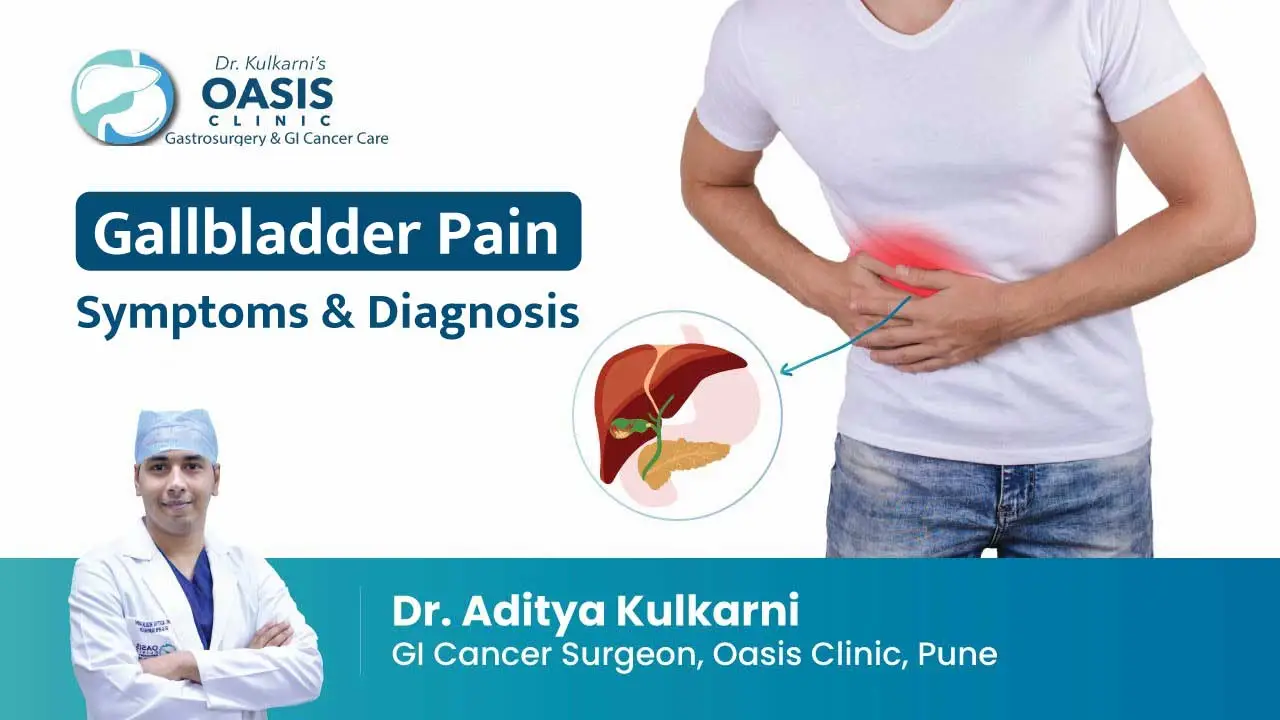Gallbladder Pain: Symptoms & Diagnosis
The Gallbladder, a 4-inch pear-shaped organ, stores bile, and other digestive juices. It may be found in the upper right quadrant of your abdomen, directly beneath your liver. Bile is a mixture of fluids, fat, and cholesterol stored in the gallbladder.
Jump On :
The digestive process relies on bile to facilitate the breakdown of fats, enhancing the absorption of fat-soluble vitamins and minerals. Among digestive health concerns, gallstones are the most common gallbladder issue and the second most prevalent overall.
Dr. Aditya Kulkarni at Oasis Clinic, renowned as the best gastrosurgeon in Pune, specializes in addressing these conditions with expert care.
If You Don’t Feel Like Reading, You Can Watch My Video Below
Symptoms
Some people with gallstones never experience any discomfort.
The following indications and symptoms might appear:
- Pain in the upper right quadrant of your abdomen comes on suddenly and worsens quickly.
- Sharp, stabbing pain in the middle of your stomach, just below your breastbone, that comes on suddenly and worsens swiftly.
- Experiencing discomfort in the space between your shoulder blades indicates back trouble.
- Ache in your right shoulder.
- Feelings of nausea and/or vomiting.
Dr. Aditya Kulkarni, is a Abdominal surgeon in pune at Oasis Clinic, specializes in addressing the discomfort caused by gallstones. T
he duration of gallstone discomfort can vary, lasting from a few minutes to several hours, and seeking professional care is essential for effective management and treatment.
Causes
Some people with gallstones never experience any discomfort. The following indications and symptoms might appear
The following conditions are linked to gallstone formation in the medical community, according to doctors:
- Cholesterol is excessive in your bile: The cholesterol your liver excretes is usually dissolved by substances found in bile. However, stones may develop from cholesterol if the liver excretes more of the substance than the bile can process.
- Bilirubin levels are excessively high in your bile: When your body breaks down red blood cells, it releases a substance called bilirubin. Liver cirrhosis, biliary tract infections, and several blood problems cause the liver to produce excess bilirubin.
- Your gallbladder isn’t emptying correctly: Gallstones may develop when bile becomes too concentrated because the gallbladder isn’t emptying correctly or often enough.

Risk Factors
Several things might put you at risk of developing gallstones.
- Being a female
- Being 40 or older
- Obesity or being overweight
- Sedentary behavior
- Being pregnant
- Following a high-fat diet plan
- Consuming a diet rich in cholesterol
- Adopting a low-fiber eating pattern
- Having a record of gallstones in one’s family
- Being a diabetic
- Very rapid weight loss
- Use of estrogen-containing medications, like oral contraceptives or hormone treatment medication
- Having a liver condition
Tests and Diagnosis
Before diagnosing you, your doctor will want to learn about your health, your symptoms, and your family’s health. Stomach discomfort is pinpointed with a physical examination.
Before taking blood, your doctor may also inquire about your eating habits and nutritional status. A blood test might tell you whether your gallbladder, bile ducts, pancreas, or liver are infected.
Imaging studies may generally detect Gallstones in the Gallbladder. Numerous imaging exams exist, including:
- Ultrasound: This procedure is often regarded as the gold standard for imaging tests to detect gallstones. Medical professionals often discover gallstones that do not produce any symptoms using this imaging method.
- CT scan: Gallstones and consequences like bile duct or gallbladder obstruction may be seen with X-rays and other imaging equipment.
- MRI: This procedure provides high-resolution pictures of your inside organs and may detect gallstones in the bile ducts.
- Cholescintigraphy: This imaging scan of the biliary system may detect gallbladder abnormalities and bile duct obstructions.
- Endoscopic retrograde cholangiopancreatography (ERCP): If you already have a problem, such as a gallstone trapped in your common bile duct, you may need this more intrusive operation.
You’ll get your doctor’s diagnosis and action plan once they’ve run all the appropriate tests.
Conclusion
Discomfort in the upper right quadrant of the abdomen is the most typical symptom of a gallbladder condition. Suppose imaging tests show that tiny, hardened accumulations in the gallbladder are to blame for the discomfort.
In that case, your doctor may propose gallbladder removal surgery based on the intensity of your symptoms.

Dr. Aditya Kulkarni
MS, DNB, FRCS, MCh (Surgical Gastroenterology & GI Oncology)
Dr. Aditya Kulkarni is a Consultant of Laparoscopic and Robotic Gastrointestinal, Hepato-biliary-pancreatic, and Cancer Surgeon at the Renowned Oasis Surgery Clinic Pune.
Book An Appointment

